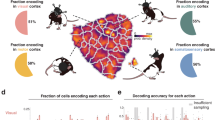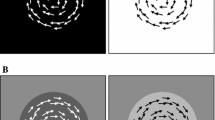Summary
Local metabolic activity was mapped in the brain ofDrosophila by the radioactive deoxyglucose technique. The distribution of label in serial autoradiographs allows us to draw the following conclusions concerning neuronal processing of visual movement information in the brain ofDrosophila.
-
1.
The visual stimuli used (homogeneous flicker, moving gratings, reversing contrast gratings) cause only a small increase in metabolic activity in the first visual neuropil (lamina).
-
2.
In the second visual neuropil (medulla) at least four layers respond to visual movement and reversing contrast gratings by increased metabolic activity; homogeneous flicker is less effective.
-
3.
With the current autoradiographic resolution (2—3 μm) no directional selectivity can be detected in the medulla.
-
4.
In the lobula, the anterior neuromere of the third visual neuropil, movement-specific activity is observed in three layers, two of which are more strongly labelled by ipsilateral front-to-back than by back-to-front movement.
-
5.
In its posterior counterpart, the lobula plate, four movement-sensitive layers can be identified in which label accumulation specifically depends on the direction of the movement: Ipsilateral front-to-back movement labels a superficial anterior layer, back-to-front movement labels an inner anterior layer, upward movement labels an inner posterior layer and downward movement labels a superficial posterior layer.
-
6.
A considerable portion of the stimulus-enhanced labelling of medulla and lobula complex is restricted to those columns which connect to the stimulated ommatidia. This retinotopic distribution of label suggests the involvement of movement-sensitive small-field neurons.
-
7.
Certain axonal profiles connecting the lobula plate and the lateral posterior protocerebrum are labelled by ipsilateral front-to-back movement. Presumably different structures in the same region are labelled by ipsilateral downward movement. Conspicuously labelled foci and commissures in the central brain cannot yet be associated with a particular stimulus.
The results are discussed in the light of present anatomical and physiological knowledge of the visual movement detection system of flies.
Similar content being viewed by others
Abbreviations
- DG :
-
deoxyglucose
References
Braitenberg V, Hauser-Holschuh H (1972) Patterns of projections in the visual system of the fly II. Quantitative aspects of second order neurons in relation to models of movement perception. Exp Brain Res 16:184–209
Buchner E (1976) Elementary movement detectors in an insect visual system. Biol Cybern 24:85–101
Buchner E (1984) Behavioural analysis of spatial vision in insects. In: Ali MA (ed) Photoreception and vision in invertebrates. Plenum, New York, pp 561–621
Buchner E, Buchner S (1980) Mapping of stimulus-induced nervous activity in small brains by3H-2-deoxy-D-glucose. Cell Tissue Res 211:51–64
Buchner E, Buchner S (1983) Anatomical localization of functional activity in flies using3H-2-deoxy-D-glucose. In: Strausfeld NJ (ed) Functional neuroanatomy. Springer, Berlin Heidelberg New York Tokyo, pp 225–238
Buchner E, Buchner S, Hengstenberg R (1979) 2-deoxy-D-glucose maps movement-specific nervous activity in the second visual ganglion ofDrosophila. Science 205:687–688
Buchner E, Buchner S, Bülthoff H (1984) Identification of3H-deoxyglucose-labelled interneurons in the fly from serial autoradiographs. Brain Res 305:384–388
Bülthoff H, Götz KG (1979) Analogous motion illusion in man and fly. Nature 278:636–638
DeVoe RD (1980) Movement sensitivities of cells in the fly's medulla. J Comp Physiol 138:93–119
DeVoe RD, Ockleford EM (1976) Intracellular responses from cells of the fly,Calliphora erythrocephala. Biol Cybern 23:13–24
Durham D, Woolsey TA, Kruger L (1981) Cellular localization of 2-3H-deoxy-D-glucose from paraffin-embedded brains. J Neurosci 1:519–526
Evequoz V, Stadelmann A, Tsacopoulos M (1983) The effect of light on glycogen turnover in the retina of the intact honeybee drone (Apis mellifera). J Comp Physiol 150:69–75
Fischbach KF (1983) Neurogenetik am Beispiel des visuellen Systems vonDrosophila melanogaster. Habilitationsschrift, Würzburg
Götz KG (1983) Genetic defects of visual orientation inDrosophila. Verh Dtsch Zool Ges 1983:83–99
Götz KG, Buchner E (1978) Evidence for one-way movement detection in the visual system ofDrosophila. Biol Cybern 31:243–248
Hausen K (1984) The lobula-complex of the fly: structure, function and significance in visual behaviour. In: Ali MA (ed) Photoreception and vision in invertebrates. Plenum, New York, pp 523–559
Heisenberg M, Wolf R (1984) Vision inDrosophila. Springer, Berlin Heidelberg New York Tokyo (in press)
Hengstenberg R (1982) Common visual response properties of giant vertical cells in the lobula plate of the blowflyCalliphora. J Comp Physiol 149:179–193
Hengstenberg R, Hausen K, Hengstenberg B (1982) The number and structure of giant vertical cells (VS) in the lobula plate of the blowflyCalliphora erythrocephala. J Comp Physiol 149:163–177
Hengstenberg R, Bülthoff H, Hengstenberg B (1983) Three-dimensional reconstruction and stereoscopic display of neurons in the fly visual system. In: Strausfeld NJ (ed) Functional neuroanatomy. Springer, Berlin Heidelberg New York Tokyo, pp 183–205
Laughlin SB (1984) The roles of parallel channels in early visual processing by the arthropod eye. In: Ali MA (ed) Photoreception and vision in invertebrates. Plenum, New York, pp 457–481
Mimura K (1972) Neural mechanisms, subserving directional selectivity of movement in the optic lobe of the fly. J Comp Physiol 80:409–437
Poggio T, Reichardt W (1976) Visual control of orientation behaviour in the fly. Part II: Towards the underlying neural interactions. Q Rev Biophys 9:377–438
Reichardt W (1973) Musterinduzierte Flugorientierung. Verhaltensversuche an der FliegeMusca domestica. Naturwissenschaften 60:122–138
Reichardt W, Poggio T (1976) Visual control of orientation behaviour in the fly. Part I: A quantitative analysis. Q Rev Biophys 9:311–375
Schwartz WJ, Smith CB, Davidsen L, Sokoloff L, Mata M, Fink DJ, Gainer H (1979) Metabolic mapping of functional activity in the hypothalamo-neuro-hypophysial system of the rat. Science 205:723–725
Sejnowski TJ, Reingold SC, Kelley BB, Gelperin A (1980) Localization of3H-2-deoxyglucose in single molluscan neurones. Nature 287:449–451
Sokoloff L (1982) The radioactive deoxyglucose method. Theory, procedure, and applications for the measurement of local glucose utilization in the central nervous system. Adv Neurochem 4:1–82
Sokoloff L, Reivich M, Kennedy C, Des Rosiers MH, Pettigrew KD, Sakurada O, Shinohara M (1977) The14C-deoxyglucose method for the measurement of local cerebral glucose utilization: theory, procedure, and normal values in the conscious and anesthetized albino rat. J Neurochem 28:897–916
Srinivasan MV, Dvorak DR (1980) Spatial processing of visual information in the movement-detecting pathway of the fly. J Comp Physiol 140:1–23
Strausfeld NJ (1976) Atlas of an insect brain. Springer, Berlin Heidelberg New York
Strausfeld NJ (1984) Functional anatomy of the blowfly's visual system. In: Ali MA (ed) Photoreception and vision in invertebrates. Plenum, New York, pp 483–522
Torre V, Poggio T (1978) A synaptic mechanism possibly underlying directional selectivity to motion. Proc R Soc Lond B 202:409–416
Wegener G (1981) Comparative aspects of energy metabolism in non-mammalian brains under normoxic and hypoxic conditions. In: Stefanovich V (ed) Animal models and hypoxia. Pergamon, Oxford, pp 87–109
Wehrhahn C, Hausen K (1980) How is tracking and fixation accomplished in the nervous system of the fly? Biol Cybern 38:179–186
Young WG, Deutsch JA (1980) Effects of blood-glucose levels on14C-2-deoxyglucose uptake in rat-brain tissue. Neurosci Lett 20:89–93
Zimmerman RP (1978) Field potential analysis and the physiology of second-order neurons in the visual system of the fly. J Comp Physiol 126:297–316
Author information
Authors and Affiliations
Rights and permissions
About this article
Cite this article
Buchner, E., Buchner, S. & Bülthoff, I. Deoxyglucose mapping of nervous activity induced inDrosophila brain by visual movement. J. Comp. Physiol. 155, 471–483 (1984). https://doi.org/10.1007/BF00611912
Accepted:
Issue Date:
DOI: https://doi.org/10.1007/BF00611912




